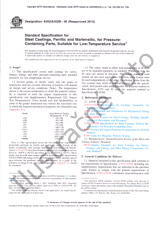Potrebujeme váš súhlas na využitie jednotlivých dát, aby sa vám okrem iného mohli ukazovať informácie týkajúce sa vašich záujmov. Súhlas udelíte kliknutím na tlačidlo „OK“.
ASTM D4305-98a(2004)e1
Standard Test Method for Filter Flow of Aviation Fuels at Low Temperatures (Withdrawn 2010) (Includes all amendments And changes 12/31/2010).
Automaticky preložený názov:
Štandardná skúšobná metóda pre Filter Tok palív leteckých pri nízkych teplotách ( Withdrawn 2010 )
NORMA vydaná dňa 1.5.2004
Informácie o norme:
Označenie normy: ASTM D4305-98a(2004)e1
Poznámka: NEPLATNÁ
Dátum vydania normy: 1.5.2004
Kód tovaru: NS-26765
Počet strán: 5
Približná hmotnosť: 15 g (0.03 libier)
Krajina: Americká technická norma
Kategória: Technické normy ASTM
Anotácia textu normy ASTM D4305-98a(2004)e1 :
Keywords:
aviation fuels, filter flow, flow point, freezing point, ICS Number Code 75.160.20 (Liquid fuels)
Doplňujúce informácie
| Significance and Use | ||||||||
|
The lowest temperature at which aviation fuels remain free of solid hydrocarbon crystals, which may restrict the flow of fuel through filters in an aircraft fuel system, is a key safety parameter in the specification and use of fuels. In Test Method D 2386, the freezing point is defined as the temperature at which all crystals disappear following a cooling and warming cycle. In this test method, a cooling and warming cycle is also employed; however, the test result is defined as the flow point, which is the temperature of the specimen at which a test filter becomes unblocked on warming. |
||||||||
| 1. Scope | ||||||||
|
1.1 This test method covers the determination of low temperature flow behavior, through a screen-type test filter, of aviation turbine fuels, which can contain separated solids as wax. 1.2 Procedure A employs a 26-μm test filter and is the recommended procedure. Some existing instruments are fitted with a 42-μm filter, and Procedure B is retained to enable their continued use. 1.3 The use of Procedure A (26-μm test filter) with fuels that have a viscosity of greater than 5.0 mm2/s (cSt) at -20°C, as determined by Test Method D 445, can affect the precision and the simulated freezing point obtained on such fuels and can give a higher (warmer) result than the conventional freezing point obtained by Test Method D 2386. Note 1—The principle of this test method relies on flow through a fine-mesh test filter, and, hence, the result can be affected by the viscosity of the sample. When using Procedure A, a no-flow condition is reached when crystals block the test filter or the viscosity exceeds about 14 mm2/s (cSt); sample with a viscosity of greater than 5 mm2/s (cSt) at -20°C may exceed the 14-mm2/s (cSt) threshold at a temperature before crystals are formed. If viscosity affects the result before crystals are formed, then the reported value of the no-flow temperature of the sample will always be warmer than the actual freezing point, and therefore fail-safe and an indicator of possible flow anomalies at low temperature. 1.4 This standard does not purport to address all of the safety concerns, if any, associated with its use. It is the responsibility of the user of this standard to establish appropriate safety and health practices and determine the applicability of regulatory limitations prior to use. |
||||||||
| 2. Referenced Documents | ||||||||
|




 Cookies
Cookies
